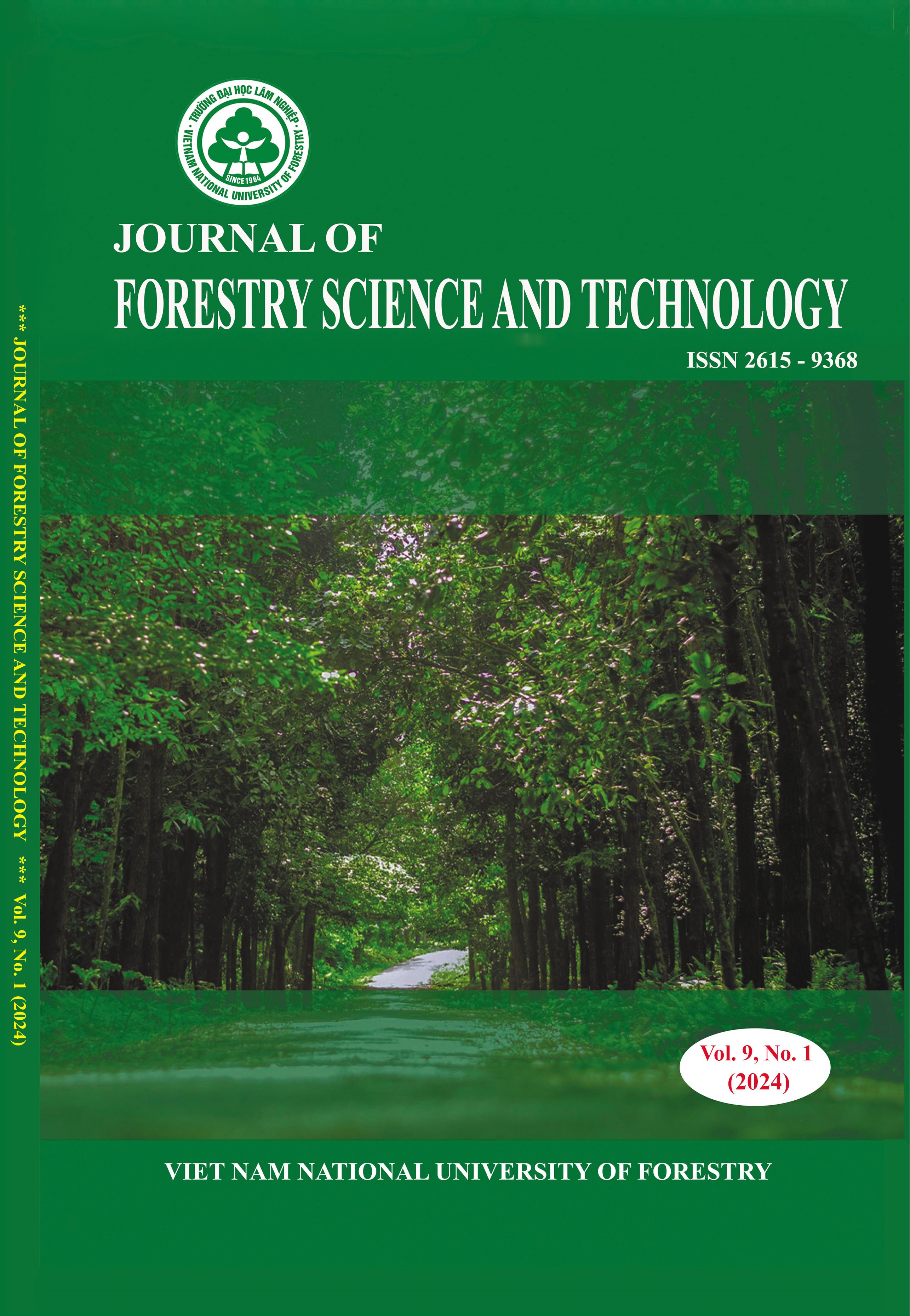Applying GIS and Markov chain in establishing the land use change map and forecasting land use changes in Thach That district, Hanoi city
DOI:
https://doi.org/10.55250/Jo.vnuf.9.1.2024.096-105Keywords:
GIS, land-use change, land-use planning, Markov chain, Thach ThatAbstract
The study applied GIS and Markov chains to assess land use changes in the period 2015-2020 and forecast land use change trends in Thach That district, Hanoi city until 2030. Using two maps of the land use status quo map in 2015 and 2020 of Thach That district and 2 period land statistics, the research result has established a land use change map in Thach That district for the period 2015 - 2020 for 16 types of land with a land change rate of 9.63% of the total natural area. During this period, the land types that tend to increase are Perennial crop land; Special-use Forest land; Aquaculture land; Other agricultural land; Residential land; Special-use land; Land for religious establishments; Land for beliefs establishments and Specialized water surfaces with an increased rate of 0.05-2.28%. In contrast, land types with a decreasing trend are Annual crop land; Production Forest land; Protective Forest land; Cemetery land, cemetery, funeral home, crematorium; Land of rivers, streams, canals and streams; Other non-agricultural land, and Unused land which decreased at a rate of 0.02-2.34%. It is forecast that by 2030, agricultural land will have 10,271.28 hectares (accounting for 54.90%), non-agricultural land will have 8,432.22 hectares (accounting for 45.07%), unused land will have 4.76 hectares (accounting for 0.03%). Performing a T-Test (Paired two sample for Means) between the area from the forecast and the planned area until 2030 shows that ρ = 0.979 > 0.05. Thus, it proves that the results of forecasting land use changes to 2030 using the Markov chain compared to the land use planning plan of Thach That district do not have too big a difference. The results of assessing land use changes and making forecasts of land change trends in the Thach That district contribute to helping policymakers have an objective view of land-use planning and economic development sustainably.
References
. Shi Qing Wang, XQ Zheng & XB Zang (2012). Accuracy assessments of land use change simulation based on Markov-cellular automata model. Procedia Environmental Sciences. 13: 1238-1245.
. Trong The Phan, Thi Huyen Mai & Ba Long Nguyen (2023). Assessing and forecasting land use changes based on applying gis and markov chain in Nhon Trach district, Dong Nai province. Journal of Forestry Science and Technology. 12(2): 146 – 155
DOI: https://doi.org/10.55250/jo.vnuf.2023.2.146-155
. David J Campbell, David P Lusch, Thomas A Smucker & Edna E Wangui (2005). Multiple methods in the study of driving forces of land use and land cover change: a case study of SE Kajiado District, Kenya. Human Ecology. 33: 763-794.
. Trong Phuong Tran & Thanh Son Ngo (2021). Assessment of land use changes in Loc Ha district, Ha Tinh province by GIS technology. Vietnam Journal of Agriculture and Rural development. 422: 145-151.
. Muhammad Qasim, Klaus Hubacek, Mette Termansen & Ahmad Khan (2011). Spatial and temporal dynamics of land use pattern in District Swat, Hindu Kush Himalayan region of Pakistan. Applied Geography. 31(2): 820-828.
. Thi Thu Ha Tran (2016). Predicting land use change affected by population growth by integrating logistic regression, Markov chain and cellular automata models. Hanoi University of Mining and Geology.
. Hanh Hong Tran, Anh Van Tran & Nghi Thanh Le (2020). Study on land use changes, causes and impacts by remote sensing, GIS and Delphi methods in the coastal area of Ca Mau province in 30 years. Journal of Mining and Earth Sciences. 61(4): 36-45.
. Minh Tuan Vu & Van Trung Le (2011). Applying remote sensing and GIS to evaluate changes and forecast urban land in Hiep Binh Phuoc ward, Thu Duc district. Proceedings of the 2011 national GIS conference.
. Hoang Vu Phan, Cam Tu Tran, Thanh Vu Pham & Quang Minh Vo (2017). Applying geographic information system and Markov chains for assessing the fluctuation and forecast of land use demand. Can Tho Univ. J. Sci. 119-124.
DOI: 10.22144/ctu.jsi.2017.016.
. Van Khanh Dao & Trong Truong Son Nguyen (2019). Research and forecast land use changes in Phu Tho province through application of Markov chain CA and GIS. Vietnam Science and Technology (VISTECH). 151-158.
. Huu Cuong Nguyen, Van Cuong Nguyen & Thanh Hang Nguyen (2022). Integration of Markov chain and logistic regression for prediction of changing land use purpose in Lam Ha district, Lam Dong province. CTU Journal of Science-CTUJoS. 58(2A): 32-42.
DOI: 10.22144/ctu.jvn.2022.034.
. People's Committee of Thach That district (2020). Explanatory report on land statistics in 2019.
. People's Committee of Thach That district (2016). Land statistical report of Thach That district, Hanoi city in 2015.
. People's Committee of Thach That district (2021). Land statistical report of Thach That district, Hanoi City in 2020.
. Ministry of Natural Resources and Environment (2018). Circular 27/2018/TT-BTNMT, Regulations on statistics, land inventory and land-use status quo mapping.
. Miles G Logsdon, Earl J Bell & Frank V Westerlund (1996). Probability mapping of land use change: A GIS interface for visualizing transition probabilities. Computers, Environment and Urban Systems. 20(6): 389-398.
. LI Jianping, Zhang Bai & Gao Feng (2005). RS-and-GIS-supported forecast of grassland degradation in southwest Songnen plain by Markov model. Geo-spatial Information Science. 8(2): 104-109.









